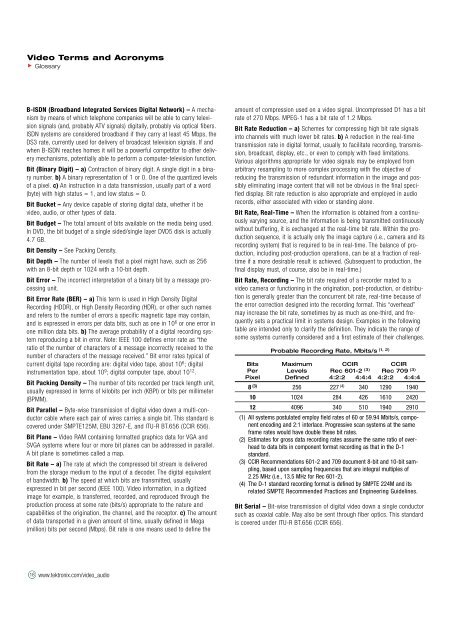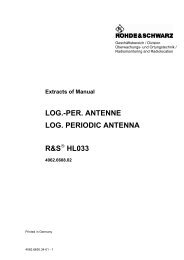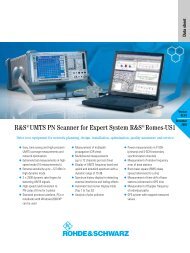Glossary of Video Terms and Acronyms - Isotest
Glossary of Video Terms and Acronyms - Isotest
Glossary of Video Terms and Acronyms - Isotest
You also want an ePaper? Increase the reach of your titles
YUMPU automatically turns print PDFs into web optimized ePapers that Google loves.
<strong>Video</strong> <strong>Terms</strong> <strong>and</strong> <strong>Acronyms</strong><br />
<strong>Glossary</strong><br />
B-ISDN (Broadb<strong>and</strong> Integrated Services Digital Network) – A mechanism<br />
by means <strong>of</strong> which telephone companies will be able to carry television<br />
signals (<strong>and</strong>, probably ATV signals) digitally, probably via optical fibers.<br />
ISDN systems are considered broadb<strong>and</strong> if they carry at least 45 Mbps, the<br />
DS3 rate, currently used for delivery <strong>of</strong> broadcast television signals. If <strong>and</strong><br />
when B-ISDN reaches homes it will be a powerful competitor to other delivery<br />
mechanisms, potentially able to perform a computer-television function.<br />
Bit (Binary Digit) – a) Contraction <strong>of</strong> binary digit. A single digit in a binary<br />
number. b) A binary representation <strong>of</strong> 1 or 0. One <strong>of</strong> the quantized levels<br />
<strong>of</strong> a pixel. c) An instruction in a data transmission, usually part <strong>of</strong> a word<br />
(byte) with high status = 1, <strong>and</strong> low status = 0.<br />
Bit Bucket – Any device capable <strong>of</strong> storing digital data, whether it be<br />
video, audio, or other types <strong>of</strong> data.<br />
Bit Budget – The total amount <strong>of</strong> bits available on the media being used.<br />
In DVD, the bit budget <strong>of</strong> a single sided/single layer DVD5 disk is actually<br />
4.7 GB.<br />
Bit Density – See Packing Density.<br />
Bit Depth – The number <strong>of</strong> levels that a pixel might have, such as 256<br />
with an 8-bit depth or 1024 with a 10-bit depth.<br />
Bit Error – The incorrect interpretation <strong>of</strong> a binary bit by a message processing<br />
unit.<br />
Bit Error Rate (BER) – a) This term is used in High Density Digital<br />
Recording (HDDR), or High Density Recording (HDR), or other such names<br />
<strong>and</strong> refers to the number <strong>of</strong> errors a specific magnetic tape may contain,<br />
<strong>and</strong> is expressed in errors per data bits, such as one in 106 or one error in<br />
one million data bits. b) The average probability <strong>of</strong> a digital recording system<br />
reproducing a bit in error. Note: IEEE 100 defines error rate as “the<br />
ratio <strong>of</strong> the number <strong>of</strong> characters <strong>of</strong> a message incorrectly received to the<br />
number <strong>of</strong> characters <strong>of</strong> the message received.” Bit error rates typical <strong>of</strong><br />
current digital tape recording are: digital video tape, about 106 ; digital<br />
instrumentation tape, about 109 ; digital computer tape, about 1012 .<br />
Bit Packing Density – The number <strong>of</strong> bits recorded per track length unit,<br />
usually expressed in terms <strong>of</strong> kilobits per inch (KBPI) or bits per millimeter<br />
(BPMM).<br />
Bit Parallel – Byte-wise transmission <strong>of</strong> digital video down a multi-conductor<br />
cable where each pair <strong>of</strong> wires carries a single bit. This st<strong>and</strong>ard is<br />
covered under SMPTE125M, EBU 3267-E, <strong>and</strong> ITU-R BT.656 (CCIR 656).<br />
Bit Plane – <strong>Video</strong> RAM containing formatted graphics data for VGA <strong>and</strong><br />
SVGA systems where four or more bit planes can be addressed in parallel.<br />
A bit plane is sometimes called a map.<br />
Bit Rate – a) The rate at which the compressed bit stream is delivered<br />
from the storage medium to the input <strong>of</strong> a decoder. The digital equivalent<br />
<strong>of</strong> b<strong>and</strong>width. b) The speed at which bits are transmitted, usually<br />
expressed in bit per second (IEEE 100). <strong>Video</strong> information, in a digitized<br />
image for example, is transferred, recorded, <strong>and</strong> reproduced through the<br />
production process at some rate (bits/s) appropriate to the nature <strong>and</strong><br />
capabilities <strong>of</strong> the origination, the channel, <strong>and</strong> the receptor. c) The amount<br />
<strong>of</strong> data transported in a given amount <strong>of</strong> time, usually defined in Mega<br />
(million) bits per second (Mbps). Bit rate is one means used to define the<br />
18 www.tektronix.com/video_audio<br />
amount <strong>of</strong> compression used on a video signal. Uncompressed D1 has a bit<br />
rate <strong>of</strong> 270 Mbps. MPEG-1 has a bit rate <strong>of</strong> 1.2 Mbps.<br />
Bit Rate Reduction – a) Schemes for compressing high bit rate signals<br />
into channels with much lower bit rates. b) A reduction in the real-time<br />
transmission rate in digital format, usually to facilitate recording, transmission,<br />
broadcast, display, etc., or even to comply with fixed limitations.<br />
Various algorithms appropriate for video signals may be employed from<br />
arbitrary resampling to more complex processing with the objective <strong>of</strong><br />
reducing the transmission <strong>of</strong> redundant information in the image <strong>and</strong> possibly<br />
eliminating image content that will not be obvious in the final specified<br />
display. Bit rate reduction is also appropriate <strong>and</strong> employed in audio<br />
records, either associated with video or st<strong>and</strong>ing alone.<br />
Bit Rate, Real-Time – When the information is obtained from a continuously<br />
varying source, <strong>and</strong> the information is being transmitted continuously<br />
without buffering, it is exchanged at the real-time bit rate. Within the production<br />
sequence, it is actually only the image capture (i.e., camera <strong>and</strong> its<br />
recording system) that is required to be in real-time. The balance <strong>of</strong> production,<br />
including post-production operations, can be at a fraction <strong>of</strong> realtime<br />
if a more desirable result is achieved. (Subsequent to production, the<br />
final display must, <strong>of</strong> course, also be in real-time.)<br />
Bit Rate, Recording – The bit rate required <strong>of</strong> a recorder mated to a<br />
video camera or functioning in the origination, post-production, or distribution<br />
is generally greater than the concurrent bit rate, real-time because <strong>of</strong><br />
the error correction designed into the recording format. This “overhead”<br />
may increase the bit rate, sometimes by as much as one-third, <strong>and</strong> frequently<br />
sets a practical limit in systems design. Examples in the following<br />
table are intended only to clarify the definition. They indicate the range <strong>of</strong><br />
some systems currently considered <strong>and</strong> a first estimate <strong>of</strong> their challenges.<br />
Probable Recording Rate, Mbits/s (1, 2)<br />
Bits Maximum CCIR CCIR<br />
Per Levels Rec 601-2 (3) Rec 709 (3)<br />
Pixel Defined 4:2:2 4:4:4 4:2:2 4:4:4<br />
8 (3) 256 227 (4) 340 1290 1940<br />
10 1024 284 426 1610 2420<br />
12 4096 340 510 1940 2910<br />
(1) All systems postulated employ field rates <strong>of</strong> 60 or 59.94 Mbits/s, component<br />
encoding <strong>and</strong> 2:1 interlace. Progressive scan systems at the same<br />
frame rates would have double these bit rates.<br />
(2) Estimates for gross data recording rates assume the same ratio <strong>of</strong> overhead<br />
to data bits in component format recording as that in the D-1<br />
st<strong>and</strong>ard.<br />
(3) CCIR Recommendations 601-2 <strong>and</strong> 709 document 8-bit <strong>and</strong> 10-bit sampling,<br />
based upon sampling frequencies that are integral multiples <strong>of</strong><br />
2.25 MHz (i.e., 13.5 MHz for Rec 601-2).<br />
(4) The D-1 st<strong>and</strong>ard recording format is defined by SMPTE 224M <strong>and</strong> its<br />
related SMPTE Recommended Practices <strong>and</strong> Engineering Guidelines.<br />
Bit Serial – Bit-wise transmission <strong>of</strong> digital video down a single conductor<br />
such as coaxial cable. May also be sent through fiber optics. This st<strong>and</strong>ard<br />
is covered under ITU-R BT.656 (CCIR 656).





